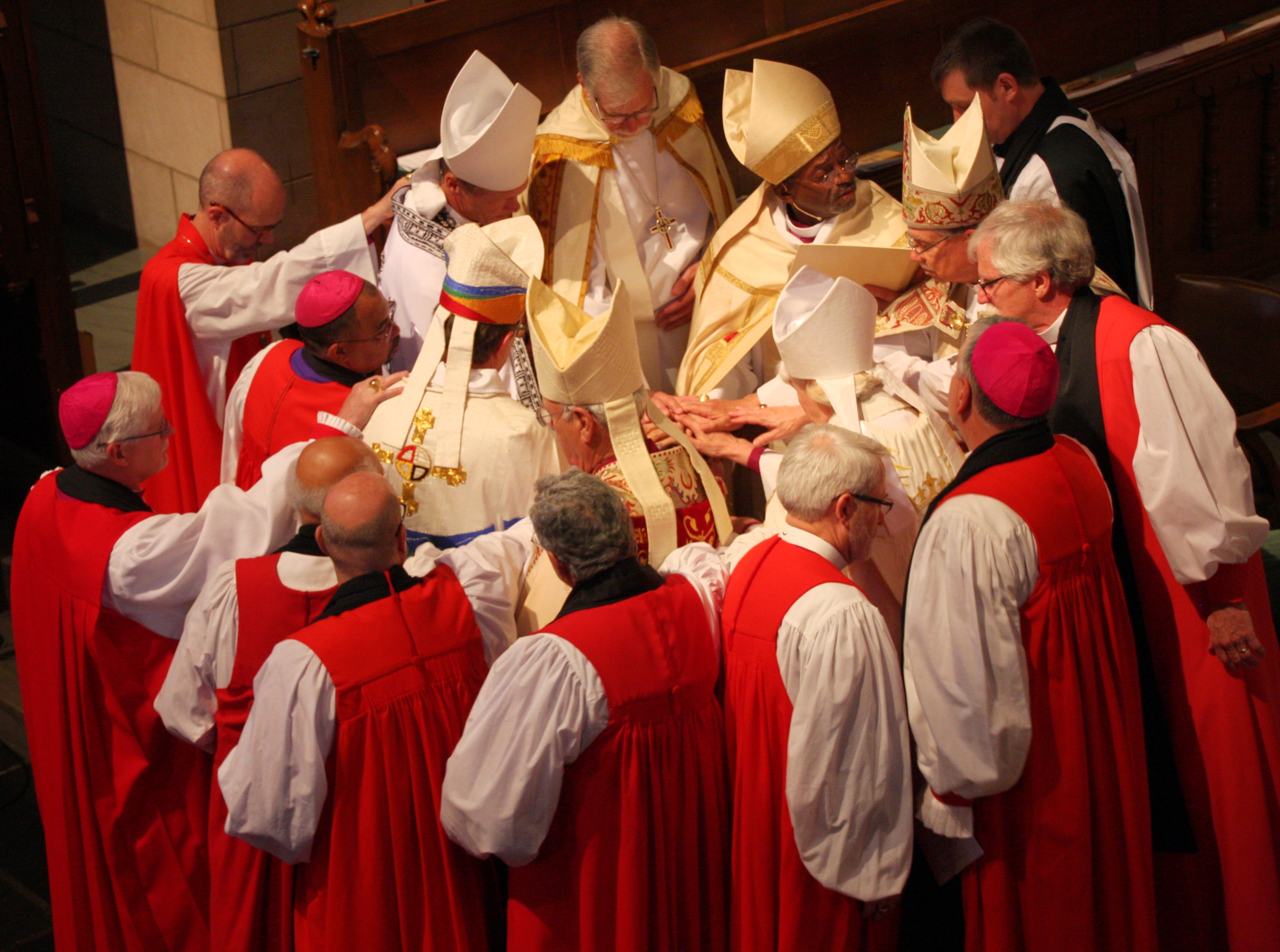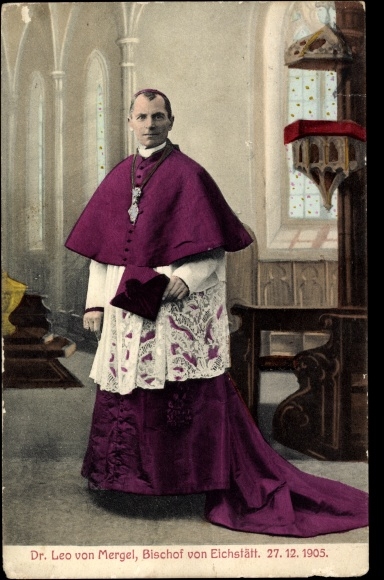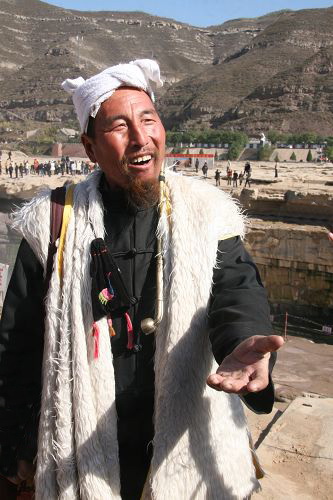|
Chimere
A chimere ( , or ) is a garment worn by Anglican bishops in choir dress, and, formally as part of academic dress. A descendant of a riding cloak, the chimere resembles an academic gown but without sleeves, and is usually made of scarlet or black cloth. In modern English use the garment is worn as part of the ceremonial dress of Anglican bishops. It is a long sleeveless gown of silk or satin, open down the front, gathered in at the back between the shoulders, and with slits for the arms. It is worn over the rochet, colored either black or scarlet (a combination referred to as "convocation robes"). Ecclesiastical use The chimere is worn by the bishops of the Anglican Communion as a component of their choir habit. It is traditionally coloured either scarlet or black, although some bishops have innovated a purple chimere. The wrist-bands of the bishop's rochet typically match the colour of the chimere. For Anglican bishops, the chimere is part of their formal vesture in choir dress ... [...More Info...] [...Related Items...] OR: [Wikipedia] [Google] [Baidu] |
Rochet
A rochet () is a white vestment generally worn by a Roman Catholic or Anglican bishop in choir dress. It is unknown in the Eastern churches. The rochet in its Roman form is similar to a surplice, except that the sleeves are narrower. In its Anglican form it is a descendant of the traditional albs worn by deacons and priests. In the Roman Catholic tradition, the rochet comes below the knee and its sleeves and hem are sometimes made of lace; in the Anglican tradition, the rochet comes down almost to the hem of the cassock and its sleeves are gathered at the wrist. The word stems from the Latin ''rochettum'' (from the late Latin ''roccus'', connected with the Old High German ''roch'', ''roc'' and the A.S. ''rocc''; Dutch ''koorhemd, rochet'', French ''rochet'', German ''Rochett, Chorkleid'', Italian ''rocchetto'', Spanish ''roquete''), means an ecclesiastical vestment. Catholic use In the Catholic Church, cardinals, bishops and certain other dignitaries use a rochet, a garment t ... [...More Info...] [...Related Items...] OR: [Wikipedia] [Google] [Baidu] |
Bishop
A bishop is an ordained clergy member who is entrusted with a position of authority and oversight in a religious institution. In Christianity, bishops are normally responsible for the governance of dioceses. The role or office of bishop is called episcopacy. Organizationally, several Christian denominations utilize ecclesiastical structures that call for the position of bishops, while other denominations have dispensed with this office, seeing it as a symbol of power. Bishops have also exercised political authority. Traditionally, bishops claim apostolic succession, a direct historical lineage dating back to the original Twelve Apostles or Saint Paul. The bishops are by doctrine understood as those who possess the full priesthood given by Jesus Christ, and therefore may ordain other clergy, including other bishops. A person ordained as a deacon, priest (i.e. presbyter), and then bishop is understood to hold the fullness of the ministerial priesthood, given responsibility b ... [...More Info...] [...Related Items...] OR: [Wikipedia] [Google] [Baidu] |
Choir Dress
Choir dress is the traditional vesture of the clerics, seminarians and religious of Christian churches worn for public prayer and the administration of the sacraments except when celebrating or concelebrating the Eucharist. It differs from the vestments worn by the celebrants of the Eucharist, being normally made of fabrics such as wool, cotton or silk, as opposed to the fine brocades used in vestments. It may also be worn by lay assistants such as acolytes and choirs. It was abandoned by most of the Protestant churches that developed from the sixteenth-century Reformation. Like Eucharistic vestments, choir dress derived originally from the formal secular dress of the Roman Empire in the first centuries of the Christian era. This survived in church usage after fashion had changed. Choir dress differs from "house dress," which is worn outside of a liturgical context (whether in the house or on the street). House dress may be either formal or informal. Roman Catholic choi ... [...More Info...] [...Related Items...] OR: [Wikipedia] [Google] [Baidu] |
Choir Habit
Choir dress is the traditional vesture of the clerics, seminarians and religious of Christian churches worn for public prayer and the administration of the sacraments except when celebrating or concelebrating the Eucharist. It differs from the vestments worn by the celebrants of the Eucharist, being normally made of fabrics such as wool, cotton or silk, as opposed to the fine brocades used in vestments. It may also be worn by lay assistants such as acolytes and choirs. It was abandoned by most of the Protestant churches that developed from the sixteenth-century Reformation. Like Eucharistic vestments, choir dress derived originally from the formal secular dress of the Roman Empire in the first centuries of the Christian era. This survived in church usage after fashion had changed. Choir dress differs from "house dress," which is worn outside of a liturgical context (whether in the house or on the street). House dress may be either formal or informal. Roman Catholic choi ... [...More Info...] [...Related Items...] OR: [Wikipedia] [Google] [Baidu] |
English Reformation
The English Reformation took place in 16th-century England when the Church of England broke away from the authority of the pope and the Catholic Church. These events were part of the wider European Protestant Reformation, a religious and political movement that affected the practice of Christianity in Western Europe, Western and Central Europe. Ideologically, the groundwork for the Reformation was laid by Renaissance humanism, Renaissance humanists who believed that the Bible, Scriptures were the only source of Christian faith and criticized religious practices which they considered superstitious. By 1520, Martin Luther, Martin Luther's new ideas were known and debated in England, but Protestants were a religious minority and heretics under the law. The English Reformation began as more of a political affair than a theological dispute. In 1527, Henry VIII requested an annulment of his marriage, but Pope Clement VII refused. In response, the English Reformation Parliament, Refo ... [...More Info...] [...Related Items...] OR: [Wikipedia] [Google] [Baidu] |
Zamarra (coat)
A zamarra is a sheepskin coat worn by Spanish shepherds. In the 1830s, Edward Bell Stephens strongly recommended that visitors to the Spanish Basque region purchase the zamarra, which he described as made from black Andalusian astrakhan lined with white sheepskin. It was recommended as an ideal travelling jacket, serviceable in both heat and cold, and very water-resistant. The academic garment also worn as a vestment, the chimere is closely related to the zamarra, from which it evolved during the Middle Ages. A similar coat is used in Alentejo, southern Portugal Portugal, officially the Portuguese Republic ( pt, República Portuguesa, links=yes ), is a country whose mainland is located on the Iberian Peninsula of Southwestern Europe, and whose territory also includes the Atlantic archipelagos of ..., and called ''samarra''. It is made of wool, with a furry collar, and the usual colours are brown, dark blue or black. See also * References Spanish clothing Portugue ... [...More Info...] [...Related Items...] OR: [Wikipedia] [Google] [Baidu] |
Vestment
Vestments are liturgical garments and articles associated primarily with the Christian religion, especially by Eastern Churches, Catholics (of all rites), Anglicans, and Lutherans. Many other groups also make use of liturgical garments; this was a point of controversy in the Protestant Reformation and sometimes since, in particular during the ritualist controversies in England in the 19th century. Origins of vestments In the early Christian churches, officers and leaders, like their congregations, wore the normal dress of civil life in the Greco-Roman world, although with an expectation that the clothing should be clean and pure during holy observances. From the 4th century onward, however, modifications began to be made to the form of the garments, and as secular fashions changed from the 6th century the church retained the original forms of their garments, although with separate development and with regional variations. Having separate, consecrated clothing for the cere ... [...More Info...] [...Related Items...] OR: [Wikipedia] [Google] [Baidu] |
William Laud
William Laud (; 7 October 1573 – 10 January 1645) was a bishop in the Church of England. Appointed Archbishop of Canterbury by Charles I in 1633, Laud was a key advocate of Charles I's religious reforms, he was arrested by Parliament in 1640 and executed towards the end of the First English Civil War in January 1645. A firm believer in episcopalianism, or rule by bishops, "Laudianism" refers to liturgical practices designed to enforce uniformity within the Church of England, as outlined by Charles. Often highly ritualistic, these were precursors to what are now known as high church views. In theology, Laud was accused of Arminianism, favouring doctrines of the historic church prior to the Reformation and defending the continuity of the English Church with the primitive and medieval church, and opposing Calvinism. On all three grounds, he was regarded by Puritan clerics and laymen as a formidable and dangerous opponent. His use of the Star Chamber to persecute opponents su ... [...More Info...] [...Related Items...] OR: [Wikipedia] [Google] [Baidu] |
Richard Scrope (bishop)
Richard le Scrope ( – 8 June 1405) was an English cleric who served as Bishop of Coventry and Lichfield and Archbishop of York and was executed in 1405 for his participation in the Northern Rising against King Henry IV. Family Richard Scrope, born about 1350, was the third son of Henry Scrope, 1st Baron Scrope of Masham, and his wife, Joan, whose surname is unknown. He had four brothers and two sisters: * Sir Geoffrey Scrope (c.1342–1362), who married Eleanor Neville, the daughter of Ralph de Neville, 2nd Baron Neville, by Alice, daughter of Hugh de Audley, and was slain at the siege of the Castle of Piskre in Lithuania in 1362, dying without issue. * Stephen Scrope (c.1345 – 25 January 1406), 2nd Baron Scrope of Masham * Henry Scrope (1359 - 1425), 4th Lord FitzHugh, 3rd Baron of Ravensworth, who married Lady Elizabeth DeGrey (1365 - 1427) * Sir John Scrope, who married Elizabeth Strathbogie * Joan Scrope, who married Henry FitzHugh, 2nd Baron FitzHugh * I ... [...More Info...] [...Related Items...] OR: [Wikipedia] [Google] [Baidu] |
Roman Senate
The Roman Senate ( la, Senātus Rōmānus) was a governing and advisory assembly in ancient Rome. It was one of the most enduring institutions in Roman history, being established in the first days of the city of Rome (traditionally founded in 753 BC). It survived the overthrow of the Roman monarchy in 509 BC; the fall of the Roman Republic in the 1st century BC; the division of the Roman Empire in AD 395; and the fall of the Western Roman Empire in 476; Justinian's attempted reconquest of the west in the 6th century, and lasted well into the Eastern Roman Empire's history. During the days of the Roman Kingdom, most of the time the Senate was little more than an advisory council to the king, but it also elected new Roman kings. The last king of Rome, Lucius Tarquinius Superbus, was overthrown following a coup d'état led by Lucius Junius Brutus, who founded the Roman Republic. During the early Republic, the Senate was politically weak, while the various executive magistr ... [...More Info...] [...Related Items...] OR: [Wikipedia] [Google] [Baidu] |
Tabard
A tabard is a type of short coat that was commonly worn by men during the late Middle Ages and early modern period in Europe. Generally worn outdoors, the coat was either sleeveless or had short sleeves or shoulder pieces. In its more developed form it was open at the sides, and it could be worn with or without a belt. Though most were ordinary garments, often work clothes, tabards might be emblazoned on the front and back with a heraldry, coat of arms (livery), and in this form they survive as the distinctive garment of Officer of Arms, officers of arms. In modern British English, British usage, the term has been revived for what is known in American English as a Apron#Tabard, cobbler apron: a lightweight open-sided upper overgarment, of similar design to its medieval and heraldic counterpart, worn in particular by workers in the catering, cleaning and healthcare industries as Personal protective equipment, protective clothing, or outdoors by those requiring high-visibility clo ... [...More Info...] [...Related Items...] OR: [Wikipedia] [Google] [Baidu] |
Rubric
A rubric is a word or section of text that is traditionally written or printed in red ink for emphasis. The word derives from the la, rubrica, meaning red ochre or red chalk, and originates in Medieval illuminated manuscripts from the 13th century or earlier. In these, red letters were used to highlight initial capitals (particularly of psalms), section headings and names of religious significance, a practice known as rubrication, which was a separate stage in the production of a manuscript. Rubric can also mean the red ink or paint used to make rubrics, or the pigment used to make it. Although red was most often used, other colours came into use from the late Middle Ages onwards, and the word rubric was used for these also. Medievalists can use patterns of rubrication to help identify textual traditions. Various figurative senses of the word have been extended from its original meaning. Usually these senses are used within the set phrase "under hateverrubric", for example, "u ... [...More Info...] [...Related Items...] OR: [Wikipedia] [Google] [Baidu] |










